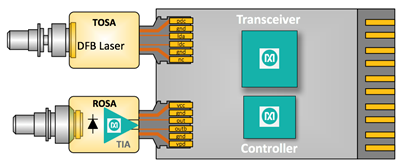By Christine Young, Blogger, Maxim Integrated
Content-focused companies like Microsoft, Google, and Facebook are now running hyperscale data centers that require massive amounts of bandwidth. Optical networking technologies that are the foundation of these data centers are advancing at a more rapid pace today than in the past, when a generation typically spanned 10 years. These days, we’re seeing data rates double every few years. The 25Gbps per lane that’s being rolled out now will grow to 50Gbps per lane next time around, explained Andrew Sharratt, executive director of the Cloud & Data Business Unit at Maxim Integrated.
In fact, in just a few years, 25/50Gbps and 100Gbps Ethernet will become the most deployed Ethernet bandwidths, according to Crehan Research. Growing demands for host-side bandwidth as data center densities continue to increase, along with growing pressure for switching capacities to keep up, are driving these high bandwidth needs. The 25G Ethernet Consortium is striving to promote the standardization of 25Gbps and 50Gbps Ethernet.
Hyperscale data centers are projected to number 485 by 2020 (up from 259 at the end of 2015), representing 47 percent of all installed data center servers, according to the Cisco Global Cloud Index. By 2020, the report notes, 92 percent of workloads will be processed by cloud data centers versus only 8 percent by traditional data centers.
Now is the time to be ready to meet the design challenges that these trends will bring. Hyperscale data centers are just one of many hot topics at the Optical Networking and Communication Conference & Exhibition (OFC 2017) in Los Angeles. According to Sharratt, the industry continues to require optical networking technologies that deliver:
- More bandwidth for data center, enterprise, and wireless front-haul applications
- Reduced cost per Gbps
- Fast ramp into high-volume production
- Wide operational temperature range for RAN applications
- Lowest power
Higher bandwidths bring greater challenges in managing signal integrity (SI). When evaluating optical modules for a data center design, customers will be looking for benefits like a simplified design and manufacturing process, lower cost, and the ability to get to market quickly. Sharratt recommends seeking high data rate solutions that are designed to address SI, allowing customers to build SFP28 LR modules with TO header-based optics with the same ease as if they were working with a lower bandwidth design. For example, there are integrated chipsets available that eliminate the need for a driver inside the transmit optical subassembly (TOSA). By eliminating a gold box in their architecture, customers may be able to save significantly in bill of materials (BOM) costs and also simplify both the design and manufacturing processes.
 Figure 1: Maxim’s transceiver IC for SFP28 modules
Figure 1: Maxim’s transceiver IC for SFP28 modules
Posted: 24 February 2017 by
Christine Young, Blogger, Maxim Integrated
| with 0 comments